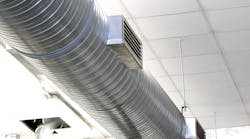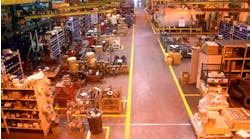Indoor air quality is closely linked with workplace productivity and health, so it is imperative that you take the right actions for your building’s occupants to breathe easy. Here are four actions you can take to ensure good quality air in your facility.
1) Listen to Feedback from Building Occupants
In many cases, if most building occupants have something to say about the air quality of their workspace, it is likely to be temperature-related, as the Center for the Built Environment at the University of California, Berkeley, found that 42% of occupants are dissatisfied with the temperature.
Maintaining good IAQ is not limited to reducing pollutants and contaminants in the air; it also requires keeping the facility at a comfortable temperature and managing humidity so employees in the workspace can work productively throughout the day. Creating an open line of communication for occupants to provide feedback on comfort levels will help develop a more productive workplace.
Even though there is no one temperature or condition that is ideal for every building occupant, a steady stream of feedback will allow you to identify problem areas throughout the facility. You can address areas with a clear pattern of discomfort by adjusting thermostats or conducting detailed inspections if the solution isn’t so simple.
While temperature might get more attention from building occupants, you also need to consider humidity. Moisture levels in the air that are too high or too low can cause problems for workers.
Related: How to Get the Most out of Your Air Filtration System
“The presence of moisture and dirt can cause molds and other biological contaminants to thrive. Relative humidity levels that are too high can contribute to the growth and spread of unhealthy biological pollutants, as can failure to dry water-damaged materials promptly (usually within 24 hours) or to properly maintain equipment with water reservoirs or drain pans (e.g. humidifiers, refrigerators and ventilation equipment),” explains the EPA. “Humidity levels that are too low, however, may contribute to irritated mucous membranes, dry eyes and sinus discomfort.”
Outside of temperature and humidity, you will also be able to see patterns in areas where workers are more frequently sick or agitated from some pollutant or contaminant. Getting firsthand accounts of how air quality is affecting occupants is one of the best and most cost-effective ways to pinpoint problems.
2) Perform Regular Ventilation Inspections and Tests
Lawrence Berkeley National Laboratory identifies a correlation with higher ventilation rates being associated with higher standardized testing scores in schools. Researchers also note that the performance of typical office tasks improves when the ventilation rate is increased, so it is important to be proactive with regular ventilation testing. Make sure that you are bringing in enough outside air and that the building is airtight, as higher ventilation rates improve productivity and cognitive function.
However, be sure that the outside air that you are bringing into your building is clean and free of pollutants. It does not matter how much air you are moving through your facility – if the air is of poor quality, you could be harming your occupants’ productivity and wellbeing. Using proper air filtration and checking it often will ensure that the air in your facility is healthy.
“When present, outdoor air pollutants such as carbon monoxide, pollen and dust may affect indoor conditions when outside air is taken into the building’s ventilation system,” explains the EPA. “Properly installed and maintained filters can trap many of the particles in this outdoor supply air. Controlling gaseous or chemical pollutants may require more specialized filtration equipment.”
As you do inspections and tests, you might find that your ventilation systems are working properly. But if you make any major changes to any of the spaces in your facility, be sure to examine how that might affect ventilation.
“Proper distribution of ventilation air throughout all occupied spaces is essential. When areas in a building are used differently than their original purpose, the HVAC system may require modification to accommodate these changes,” explains the Centers for Disease Control and Prevention. “For example, if a storage area is converted into space occupied by people, the HVAC system may require alteration to deliver enough conditioned air to the space.”
3) Practice Responsible Source Control
You can avoid a number of IAQ issues without having to make any changes to your HVAC system. If you limit the types of materials used in your facility to those that don’t bring in harmful contaminants and pollutants, you can get ahead of larger changes that might require a more costly HVAC change.
“Take steps to reduce exposures to contaminants from cleaning products and from new furnishings and building materials, when odors and chemical emissions are usually highest,” advises the EPA. “Ask the designers, suppliers and manufacturers to provide information on chemical emissions from products and any potential associated respiratory hazards. While emissions information may not yet be available for many products, many product manufacturers are starting to do emissions testing. The more consumers request such information, the sooner it will become widely available.”
However, it is difficult to remove all items that might negatively impact IAQ. Some products including solvents, adhesives, cleaners and copy equipment can give off contaminants and odors. Be aware of the impacts some materials that are used in your building can have and take appropriate actions to counteract them.
Trending: Is Your HVAC System Spreading Thirdhand Smoke?
“If any of these items are used in the office environment, adequate and sometimes separate ventilation should be provided. If your organization engages in activities that may generate pollutants, such as photographic or printing processes, exhaust ventilation will be especially important,” the EPA explains. “Pollutants and odors (which may or may not indicate a health concern) generated in your space may not only bother those in the immediate area, but may enter the building ventilation system and cause problems for other tenants in other parts of the building.”
4) Consistently Check for Visible Issues
Perhaps the simplest measure you can take is to be on the lookout for any visible issues that could cause IAQ problems. While you should undergo more formalized testing procedures, sometimes what needs to be fixed is apparent from a regular walkthrough. The presence of water is often a telltale sign that something is wrong with the system, and its effects could include contaminating the air.
“A building walk-through to check for odors and look for water damage, leaks, dirt or pest droppings may be helpful,” explains OSHA. “Leaks need to be eliminated. Standing water in humidifiers, air conditioning units, on roofs and in boiler pans can become contaminated with bacteria or fungi and need to be eliminated.”
Maintaining good air quality requires regular attention. Although you might be better served by leaving much of the testing and close inspections to HVAC professionals, FMs keeping an eye out for any developing issues is key to preserving good IAQ.
Justin Feit was the Associate Editor of BUILDINGS.
Two hand-picked articles to read next:


